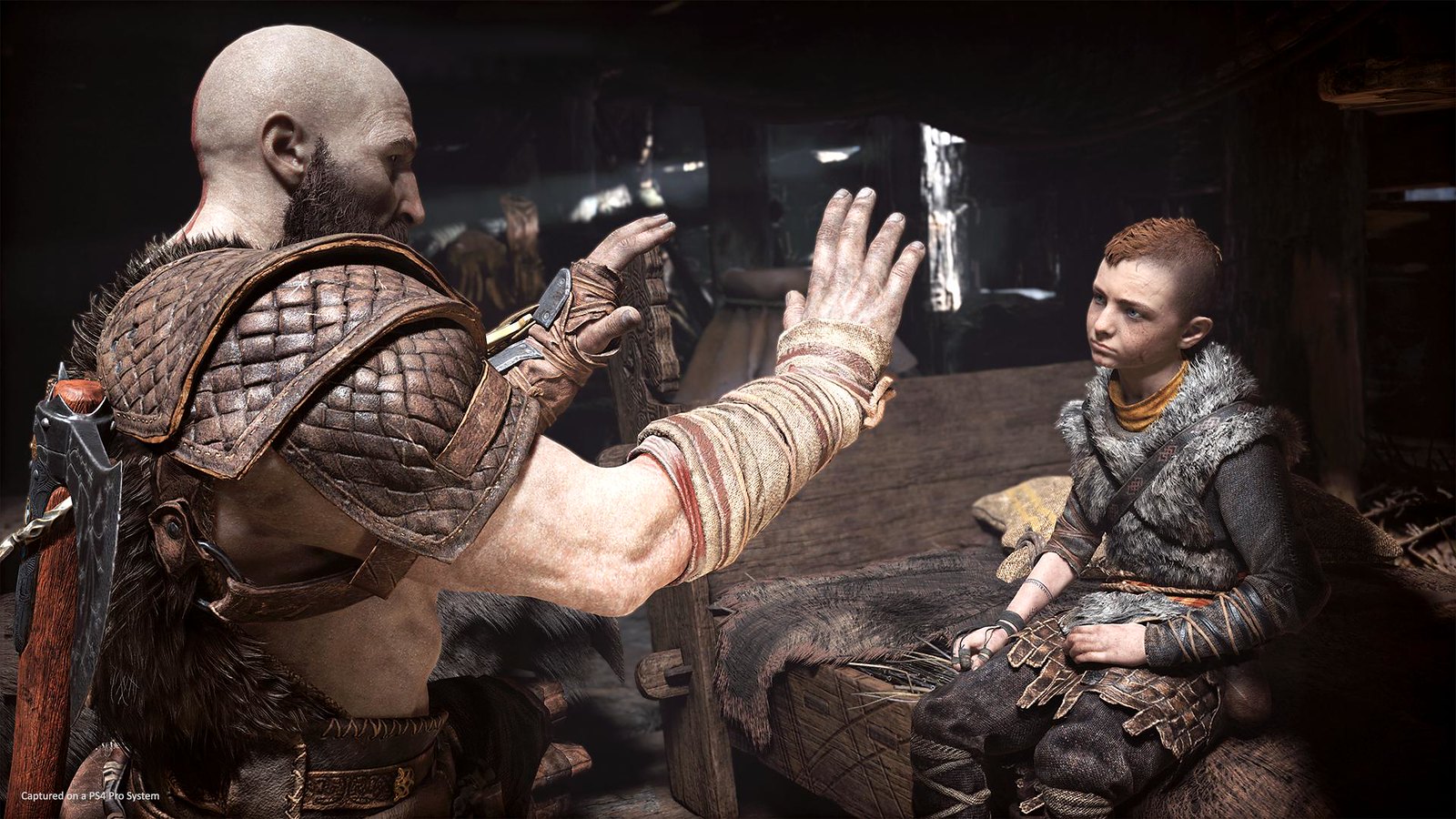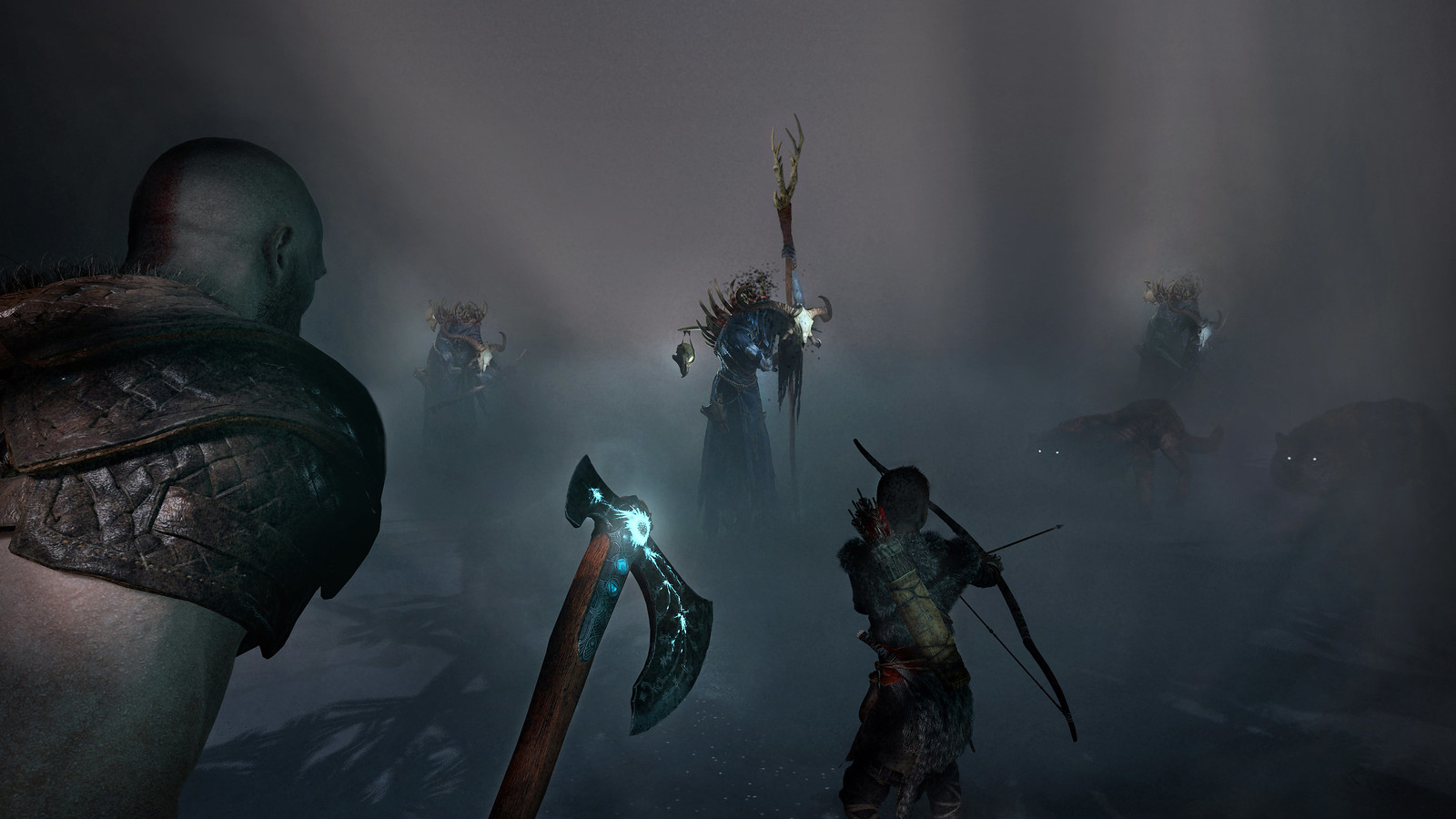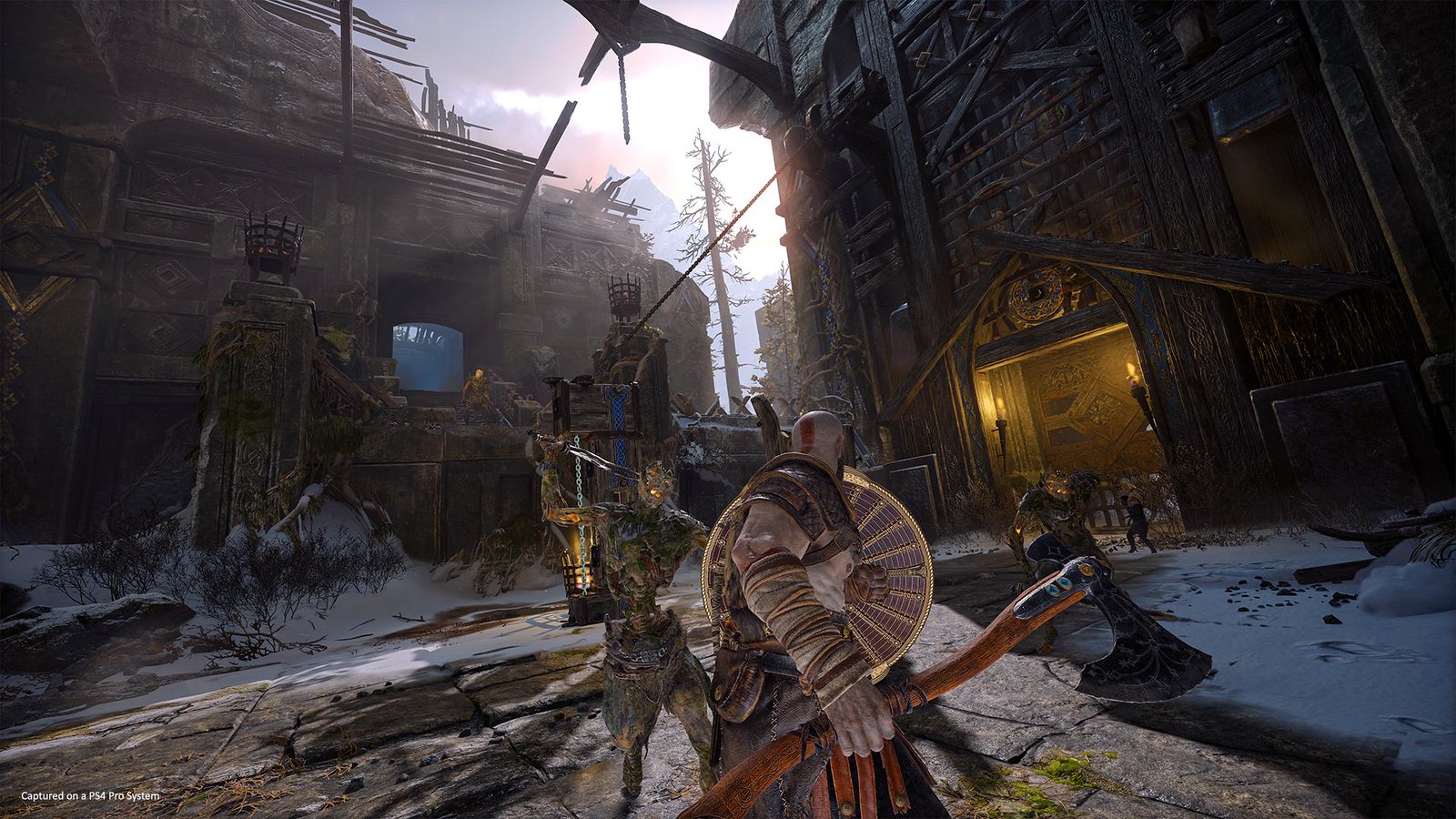Products You May Like
Innovation is king when it comes to video games, especially when reinventing a beloved franchise. Developers are challenged with balancing what fans loved about the series’ origins while modernizing the experience and providing surprising gameplay enhancements that players didn’t even know they wanted. Few developers understand this task better than Santa Monica Studio, which reimagined Kratos’ mythological melee in 2018.
The sequel God of War Ragnarök launches November 9. This new entry is poised to deliver more of the satisfying combat introduced in God of War (2018), including Kratos’ trusty Leviathan Axe and the Blades of Chaos, increased verticality in combat, versatile shield options to customize play, a host of new mythical beasts to battle, and more.
Ahead of God of War Ragnarök’s release, we invited talented game developers from PlayStation Studios and third-party studios to reflect on God of War (2018)’s impactful combat. These creators dive into everything from Kratos’ crunchy, boomeranging Leviathan Axe to the intimate camera perspective, while also sharing their personal perspective on what makes for satisfying melee combat.
“God of War 2018 was hugely inspirational. It took many aspects of action-focused games and merged them to establish a new standard that directly impacted how we approached combat when creating Ghost of Tsushima.
For example, the yellow and red ‘rings’ in God of War that indicated required player actions were highly influential and inspired the blue and red ‘glints’ in Ghost of Tsushima for unblockable/parryable attacks.
Valkyrie boss design was also a huge inspiration for us and had a major influence on the ‘Six Blades of Kojiro’ mission in Ghost of Tsushima, which involved tracking down and fighting duelists across the island. Each duelist had a unique move, but the final duel incorporated all of the various moves of the previous duelists, just like the Valkyries. I will say Sigrun the final Valkyrie kicked my butt more times than I would like, and my secret hope is that Kojiro in Ghost of Tsushima defeated many players in the same way!”
– Ted Fishman, Lead Combat Designer, Sucker Punch
“When players use heavier weapons [in Monster Hunter World] that have slower movement and attack speeds, it’s more difficult to hit monsters. An important part of designing combat for us is to create a mechanism that converts the stress of slow movement into a sense of accomplishment when the player successfully hits a target.
There are a number of ways to achieve this, and it is obviously important to have a special move that feels satisfying when you hit the target because of its heavy weight. But what is even more important, is giving players the movement options necessary to precisely position themselves in order to land that hit. These can even be small things such as taking a few steps closer to attack/taking a step back after the attack.
The combat in God of War (2018) is simple but profound. The basics of an action game are carefully implemented into this game, like your attacks becoming more effective if you respond appropriately to your opponent’s attacks. There are many options for what you can do to your opponent, such as directing projectiles and arrows even at long ranges, and switching to bare hands or [Spartan] Rage mode.
In addition, you can switch to powerful attacks depending on the state of your opponent, like when they are stunned. The amount of controls doesn’t increase, but the reaction varies, so players don’t get bored. I am amazed at the careful work that has gone into the game.”
– Yuya Tokuda, Director, Capcom
“The Last of Us Part II had a unique challenge to keep the sense of weight and impact that Joel brought to the combat in part I but translate it to a now 19-year-old Ellie all while keeping the actions realistic and fidelity extremely high. We used techniques including tight camera work, camera shakes, controller vibration, geometrical blood effects, and more to get this right. This holistic set of feedback is required to achieve the weight, impact, and general brutality The Last of Us demands.
God of War (2018) takes different approaches but is equally considered in all of these feedback vectors. One of the biggest contrasts is the different approach in camera work. God of War utilizes a further pulled back camera to enable greater field of view of the combat space. This allows the player to better track multiple targets. Camera shake is also significantly reduced. While this can hurt impact perception, it greatly improves legibility of targets and aids gameplay. What is reduced by these camera choices is made up for in audio and animation. Hit impact sounds are huge. Kratos’ axe doesn’t sound like it simply slices through, but rather has a brute force slam with lots of low end effort that ends with a high frequency slash. This is reinforced by the animation style. Swings have very large arcs with powerful follow throughs. Enemy reactions are allowed to break reality with huge pose changes, flips, and even air juggling is all used to sell the power fantasy. God of War also employs a rather subtle but powerful technique called ‘hit stop’ which on hit actually pops the target to the hit pose and holds both Kratos and the target in that first frame for a short duration. This is not realistic, but it strongly emphasizes the connection of the swing and can also simulate a sort of resistance on the follow through of the attack. And honestly, when you’re chasing weight and impact in your game, sometimes it just really helps when your protagonist is the Greek god of strength.”
– Christian Wohlwend, Principal Game Designer, Naughty Dog
“What God of War (2018) has achieved is nothing short of spectacular and a lot has already been said about Kratos’ axe and how it came to fruition – mostly thanks to exemplary openness of Cory Barlog and the whole Santa Monica Studio about their design process. But aside from all of the neat tricks inspired by Street Fighter and other beat ’em up games, the secret of God of War is hard work and relentless iteration. It’s the action-reaction loop ruthlessly polished till it’s absolutely golden. Kratos deserves nothing less and I’m sure God of War Ragnarök will deliver.
Creating a good combat system is always a long bout against time and resources, but you’ll never land the triumphant final blow unless you invest all of your focus and attention to the feedback loop of hitting your enemy and him reacting to that powerful hit. [Similarly to God of War] we have spent a lot of time on fine-tuning every hit animation [in Dying Light 2], every weapon parameter to make sure it just feels right.”
– Tymon Smektała, Lead Game Designer, Techland
“God of War was always a franchise that gave players spectacle and a sense of power like nothing else out there. When the game returned in 2018, it managed to change up the formula while staying true to the pillars that originally made it great. Pushing the camera in brought a new perspective to the carnage Kratos dealt, and with it, new weapons, abilities, and a partner to help you along the way. New innovative ways to string together combos between the different pieces of your arsenal kept you feeling like the God of War while taking the time to master the game elevated the combat even further and showed the gods of Asgard that Kratos hadn’t missed a step with his time away.”
– Adam Coriglione, Senior Combat Designer, Insomniac Games
“I believe the key to designing close combat is all about tension and release. The player should experience tension while executing attacks and feel a sense of balance as well as foreshadowing from the motion on-screen. [In Resident Evil Village] we then look to release that tension and create a liberating feeling through animations and special effects when attacks connect successfully. Although this may be a general answer, simple and crisp design is what I emphasize when developing games.
I thought it was wonderful how the melee and ranged combat elements [in God of War (2018)] were mixed together at a high level with the new Leviathan Axe weapon. This design allowed for two different approaches to the action. You can both take out enemies who are far away and execute strong attacks in close quarters utilizing the same weapon. This is something I felt was revolutionary combat design!”
– Morimasa Sato, Director, Capcom
“I loved the original God of War games, the flow and ferocity of the combat for me gave them hands down the best combat in any game developed outside of Japan. When the 2018 version came around, I was trepidatious – would this attempt to ‘remake’ the formula and screw that lovely combat up?
It didn’t, of course, and instead delivered a fantastically crunchy third-person combat experience. Early in the game I knocked a bad dude off his feet with a deftly thrown axe, sent him flying into one of his horde buddies who got launched into the air too – a moment of true delight! and I knew the game was going to live up to expectations.”
– Anna Marsh, Associate Game Director, Firesprite
“Chivalry 2’s combat design paradigm is: Let players do the awesome thing. Full control over a weapon’s swing arc and the player character’s body positioning, alongside mechanics such as dodging, feinting from one attack type into another, or countering, allow players to perform dazzling symphonies of action.
By comparison, God of War (2018)’s combat is forceful, kinetic, and bombastic. It is about giving players the opportunity to live out a clear power fantasy that feels rewarding and powerful. Lots of attention is paid to hit reactions and impact kinetics, and Kratos’ axe becomes a natural extension of the player’s hands. Animation responses and input handling ensure that every action feels rewarding in itself – and combined, they lead to combat sequences that would rival those of Hollywood blockbusters.
God of War also leverages its nature as a single player game to expand the player’s toolset throughout the player’s journey, keeping the experience fresh and allowing players to define their own playstyle based on their preferences.”
– Leif Walter, Design Director, Torn Banner Studios
“God of War (2018) was an astonishing accomplishment. We can all likely agree (and discuss at length why) the Leviathan is amongst the greatest implementations of an axe in a video game, but for me it was the buddy combat behavior that really grabbed my attention.
An initial concern was the game may be one giant escort mission but Atreus was never a burden and a rare shining example of a buddy companion who dramatically improved the combat experience. I did not expect Atreus to contribute so much to the core combat, but he was fully autonomous and never passive, able to instigate and encourage combat mechanics through crowd control, distraction and air juggles. My only gripe was the uncontrollable urge to punctuate every sentence with ‘BOY’ for the months following.”
– David McMullen, Lead Systems Designer, Guerrilla
“In the Nioh series, we wanted to convey the contrast of stillness and motion in samurai battles, so we designed the game such that the player and their enemy had stamina bars, and they would have to be aware of the timing of their offensive and defensive maneuvers. Additionally, being able to utilize a Ki Pulse after an attack in order to regain your stamina is something that is very distinctive of close quarters combat in the Nioh series.
Fairness and the game having a unique feel to it is not only a feature of the Nioh series, but these are also points that Team Ninja puts the most importance on when creating close quarters combat in our games.
[In God of War (2018)], the animation and sound effects were all very high quality, but the camera work was a step above everything else and it felt incredible. When designing close quarters combat, there is a dilemma that arises on how to set up the camera in such a way that the visuals and gameplay both equally have a lot of impact to them.
However, the camera in God of War (2018) was very close to Kratos while also keeping the force of the attacks and allowing the players to feel the pain of their enemies. This was done all while the UI and effects had a lot of work put into them, without the player ever feeling the outrageousness of the camera work. The combo attacks with Atreus and the series’ staple QTEs also were implemented seamlessly, and the way this all came together was really astonishing. I am really looking forward to seeing how all of this evolves in God of War Ragnarök.”
– Hiroyuki Nishi, Combat Designer, Team Ninja
God of War Ragnarök launches on PS4 and PS5 on November 9, 2022. Brush up on your Norse mythology (by way of Kratos) with a look back at God of War (2018)’s story.



